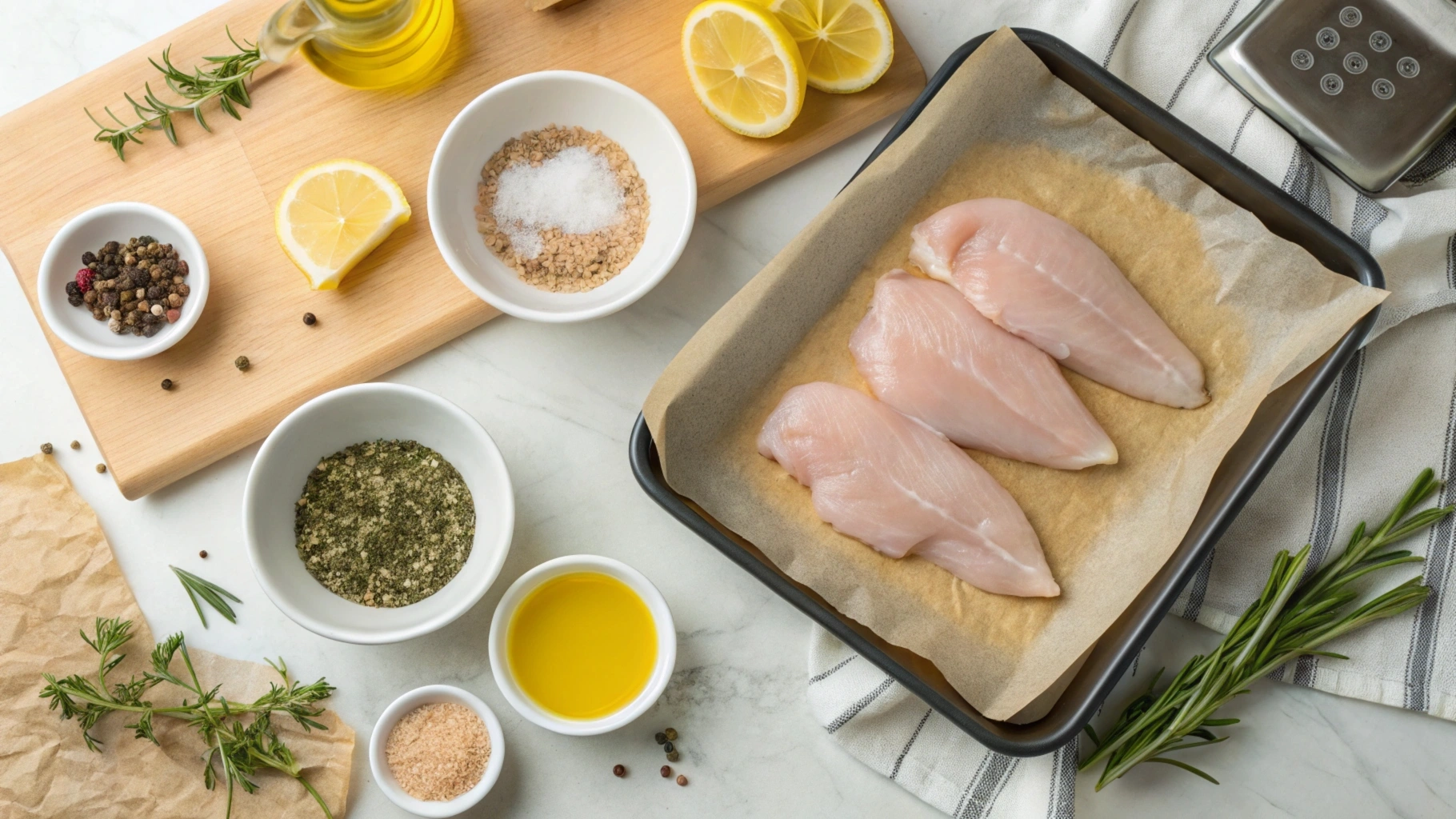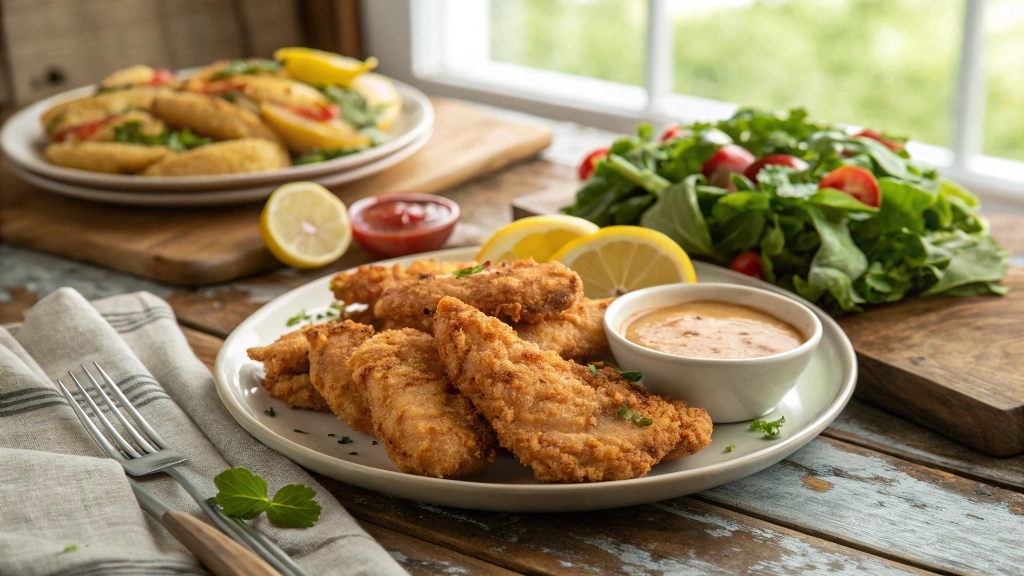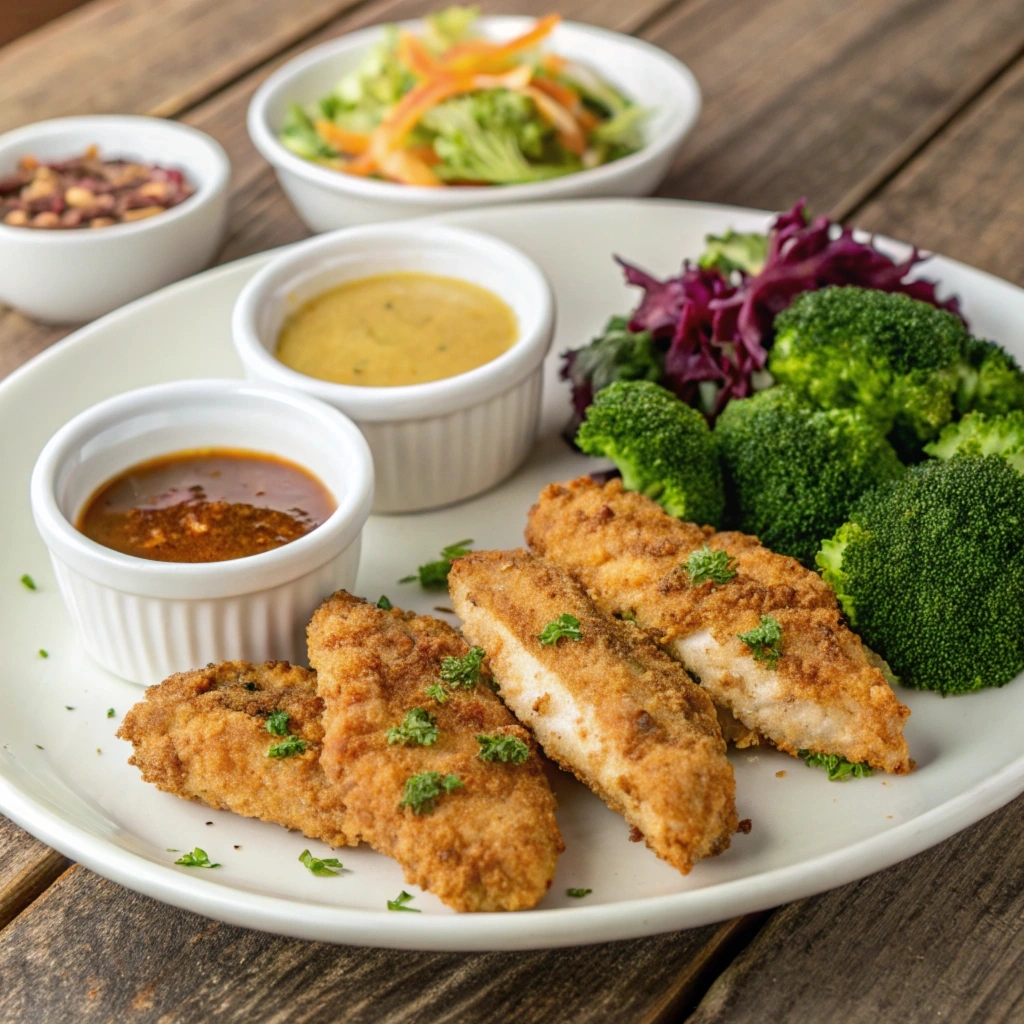Cooking chicken tenders at 400°F is the ideal way to achieve a perfect combination of crispy coating and tender, juicy meat. This temperature ensures even cooking and locks in moisture, making it the go-to choice for home cooks. If you’re wondering how to cook chicken tenders at 400, this guide will provide step-by-step instructions, tips, and variations to make your meal a success.
There’s no denying that chicken tenders have captured the hearts of both children and adults alike. Their adaptability to various flavors, from classic herbs and spices to zesty sauces, makes them a crowd-pleaser. Whether enjoyed as a main course, appetizer, or snack, they are perfect for any occasion. Additionally, their finger-food nature adds convenience, making them ideal for casual gatherings or weeknight dinners.
Importance of Cooking at the Right Temperature
The temperature at which you cook chicken tenders significantly impacts the final product. Too low, and they risk becoming rubbery and undercooked; too high, and you might end up with a burnt crust and dry meat. Achieving that perfect balance of a golden crust and tender, moist chicken relies heavily on selecting the optimal temperature.
Focus on 400°F for Baking Chicken Tenders
Baking chicken tenders at 400°F is widely considered the sweet spot for success. This temperature is hot enough to crisp up the breading for that satisfying crunch while ensuring the chicken remains juicy and flavorful inside. Furthermore, baking at this temperature reduces cooking time, making it a practical choice for busy households. By choosing 400°F, you can consistently achieve delectable results that rival any fried version.
Preparing Chicken Tenders for the Oven
When preparing to cook chicken tenders at 400, selecting the right ingredients and tools is essential. Start by choosing fresh or frozen tenders based on your convenience. Season or marinate the tenders for enhanced flavor before placing them in the oven.
When preparing to Cook Chicken Tenders at 400, you might also explore other ways to cook chicken. For example, learning How Long to Bake Chicken Tenderloins can provide useful insights for similar dishes that require precise timing and preparation.
Choosing the Right Chicken Tenders
The type and quality of chicken tenders you choose lay the foundation for your dish. Whether you prefer fresh or frozen, pre-seasoned or homemade marinades, each option has its advantages.
Fresh vs. Frozen
Fresh chicken tenders are often preferred for their taste and texture. They tend to bake more evenly, delivering consistent results. However, frozen tenders are a convenient choice for those who want to keep a stash on hand. If using frozen tenders, ensure they are properly thawed before cooking to avoid uneven baking.
Pre-seasoned vs. Homemade Marinades
Pre-seasoned chicken tenders save time, as they come pre-flavored with popular blends. However, creating your own marinade allows for customization and control over ingredients. A simple mix of olive oil, garlic, paprika, and lemon juice makes for a delicious homemade marinade that enhances the natural flavor of the chicken.
Prepping the Chicken
Preparation is key to ensuring your chicken tenders bake to perfection. Taking the time to properly thaw and season them can elevate your meal significantly.
Thawing Frozen Chicken
If using frozen chicken tenders, thaw them in the refrigerator overnight for the best results. For a quicker option, submerge them in a sealed bag in cold water, changing the water every 30 minutes until thawed.
Seasoning and Marinating Tips
For maximum flavor, season your chicken tenders generously. Dry seasoning blends are quick and easy, while marinades add depth. Allow the chicken to sit for at least 30 minutes in your marinade or seasoning mix to absorb the flavors fully.
Lining and Preheating the Oven
Before baking, preparing the oven and the baking tray is crucial for achieving evenly cooked and crispy chicken tenders.
Why 400°F is Ideal for Cooking
Baking at 400°F ensures the perfect combination of crispiness and juiciness. This temperature is optimal for creating a golden crust while cooking the chicken through in a relatively short time.
Tools Needed: Baking Tray, Parchment Paper
Line a sturdy baking tray with parchment paper to prevent sticking and make cleanup easier. Alternatively, a lightly greased tray works as well. Ensure the oven is preheated to 400°F before placing the chicken inside, as this helps the tenders cook evenly and quickly, locking in moisture and flavor.
Cooking Chicken Tenders in the Oven at 400°F
Once your chicken tenders are prepped, it’s time to bake them to crispy, golden perfection. Cooking at 400°F strikes the perfect balance between a crisp crust and tender, juicy meat. Following the right steps and paying attention to cooking times ensures the best results.

Step-by-Step Cooking Instructions
To successfully cook chicken tenders at 400, preheat your oven and arrange the tenders on a baking tray lined with parchment paper. Fresh tenders take 15-20 minutes to bake, while frozen ones require 20-25 minutes. Flip halfway through for even browning.
Placing Chicken Tenders on the Tray
Arrange the chicken tenders on your prepared baking tray in a single layer. Ensure there is enough space between each piece for even air circulation. Crowding the tray can lead to uneven cooking and a less crispy texture. If needed, use multiple trays to accommodate all your tenders.
Baking Times for Different Thicknesses
The thickness of your chicken tenders directly affects their cooking time. Thinner pieces may cook faster, while thicker ones will require a few extra minutes. Keeping the pieces relatively uniform in size helps to ensure even cooking.
How Long to Cook Chicken Tenders in Oven at 400°F
Baking times can vary depending on whether you’re using fresh or frozen chicken tenders.
Fresh Chicken Tenders: 15-20 Minutes
Fresh chicken tenders typically bake in 15-20 minutes at 400°F. Flip them halfway through cooking to promote even browning on both sides.
Frozen Chicken Tenders: 20-25 Minutes
Frozen chicken tenders may take 20-25 minutes to cook through. Ensure they are fully thawed before baking to avoid a rubbery texture or uneven results.
Checking Doneness
It’s vital to ensure the tenders are fully cooked. Use a meat thermometer to confirm they’ve reached 165°F. Visual cues, like a golden-brown crust, indicate your tenders are ready. Following these steps guarantees that when you cook chicken tenders at 400, they’ll turn out perfectly.
Internal Temperature: 165°F
Using a meat thermometer, check the thickest part of a tender. The internal temperature should reach 165°F, indicating the chicken is fully cooked and safe to eat.
Visual Indicators: Golden-Brown Texture
Visually, the chicken tenders should appear golden-brown with a slightly crisp exterior. If they look pale or undercooked, they may need an additional few minutes in the oven.
Tips for Ensuring Even Cooking
- Flip Midway: Turn the tenders halfway through the cooking process to achieve consistent browning on both sides.
- Use a Wire Rack: For extra crispiness, place the tenders on a wire rack set over a baking tray. This allows heat to circulate around the chicken, preventing soggy bottoms.
- Avoid Overcrowding: Leave space between each tender for proper heat distribution, ensuring all pieces bake evenly.
Variations and Enhancements

Chicken tenders are a versatile dish that can be customized to suit various tastes and dietary preferences. From experimenting with breaded coatings to creating healthier versions, there are numerous ways to elevate your chicken tenders. Pair them with complementary sauces and sides for a complete and satisfying meal.
For a creative twist, you can dice your chicken tenders after baking and use them in versatile recipes. Check out these Diced Chicken Recipes for inspiration on how to turn baked chicken into tacos, salads, or pasta dishes.
Adding Breaded Coatings
A good coating is essential for achieving that irresistible crunch, and there are plenty of options to choose from based on your preferences or dietary needs.
Panko, Breadcrumbs, and Alternatives
- Panko Breadcrumbs: Light and airy, panko creates an extra-crispy texture, perfect for those who love a crunch in every bite.
- Traditional Breadcrumbs: These offer a classic, slightly denser crust that pairs well with herb and spice blends.
- Alternatives: Crushed cornflakes, almond flour, or finely ground oats can be used as substitutes for traditional breadcrumbs, adding unique flavors and textures to the tenders.
Making Healthier Versions
For those looking to enjoy chicken tenders with fewer calories or without gluten, simple adjustments can make all the difference.
Low-Calorie Options
Bake the tenders without breading or use a light coating of whole-grain breadcrumbs. Spraying them with a small amount of olive oil helps achieve a crispy texture without frying.
Gluten-Free Options
Opt for gluten-free breadcrumbs or use almond flour or crushed rice crackers as a coating. Pair with seasonings like smoked paprika and garlic powder for a burst of flavor.
Pairing Suggestions
Chicken tenders are made even better with the right sauces and side dishes. Here are some ideas to complete your meal.
Baked chicken tenders pair beautifully with salads for a balanced meal. Consider trying a flavorful Mexican Chicken Salad to complement the crispy tenders and add a zesty kick to your plate.
Sauces: Honey Mustard, BBQ, Ranch
- Honey Mustard: A sweet and tangy dip that complements the savory chicken.
- BBQ Sauce: Smoky and rich, it adds depth to every bite.
- Ranch Dressing: Creamy and herby, perfect for cooling down spicier seasonings.
Side Dishes: Salads, Fries, Vegetables
- Salads: A fresh green salad with vinaigrette balances the richness of the chicken.
- Fries: Classic pairing with crispy or sweet potato fries.
- Vegetables: Steamed or roasted veggies, like broccoli or carrots, add a healthy and colorful side.
Troubleshooting and Common Questions
Wondering why your chicken tends to dry out or undercook? Proper timing and preparation are crucial when you cook chicken tenders at 400. Adjust for convection ovens and always check for doneness to ensure consistent results.
Why Are My Chicken Tenders Dry?
Dry chicken tenders can ruin an otherwise delightful meal. This issue typically stems from overcooking or insufficient moisture during preparation.
- Overcooking: Baking chicken tenders for too long or at too high a temperature causes them to lose moisture. Stick to the recommended baking time of 15-20 minutes at 400°F for fresh tenders or 20-25 minutes for frozen ones. Use a meat thermometer to check that the internal temperature is 165°F to avoid overbaking.
- Preparation Tips: Marinate your chicken tenders before baking to lock in moisture. Even a quick 30-minute soak in a mixture of olive oil, lemon juice, and seasonings can make a big difference.
What to Do If the Tenders Are Undercooked?
Undercooked chicken can pose a safety risk and detract from the dish’s appeal. If you discover your tenders are undercooked:
- Return to Oven: Place them back in the oven immediately. An additional 5-10 minutes at 400°F should finish cooking them.
- Cut and Check: Slice through the thickest part of a tender to ensure there are no pink areas and that juices run clear.
Adjusting for Convection Ovens
Convection ovens cook food faster and more evenly by circulating hot air. If using one:
- Reduce Temperature: Lower the oven temperature by 25°F (to 375°F) to prevent overcooking or burning.
- Monitor Cooking Time: Begin checking for doneness 2-3 minutes earlier than the standard baking time.
FAQs About Cooking Chicken Tenders at 400°F
How Long Should I Cook Chicken Tenders at 400°F?
The ideal cooking time for chicken tenders at 400°F depends on their thickness and whether they are fresh or frozen. For fresh chicken tenders, bake for 15-20 minutes, flipping them halfway through to ensure even cooking. Frozen tenders require a slightly longer baking time, typically 20-25 minutes, to account for their starting temperature. Use a meat thermometer to confirm an internal temperature of 165°F for safety and optimal doneness.
Can I Cook Frozen Chicken Tenders Without Thawing?
Yes, you can cook frozen chicken tenders without thawing, but you’ll need to adjust the cooking time. Bake them directly from frozen for approximately 25-30 minutes at 400°F, flipping halfway through. Keep an eye on the internal temperature to ensure they reach 165°F. While this method is convenient, thawing beforehand often yields more even cooking and better texture.
How Do I Keep Chicken Tenders Juicy?
The key to juicy chicken tenders lies in proper preparation and monitoring during cooking. Here are some tips:
- Marinate the chicken before baking to infuse moisture and flavor.
- Avoid overcooking by checking the tenders as they near the recommended time.
- Use a meat thermometer to pull them from the oven as soon as they reach 165°F.
Spraying the tenders lightly with oil or butter before baking can also help maintain a juicy interior while creating a crispy exterior.
Is It Safe to Cook Chicken at 400°F?
Absolutely! Cooking chicken at 400°F is both safe and effective. This temperature is ideal for quickly and evenly cooking chicken tenders while preserving their moisture and texture. Always verify that the chicken’s internal temperature reaches 165°F to ensure it’s safe to eat, as recommended by USDA guidelines.
Do I Need to Flip Chicken Tenders While Baking?
Flipping chicken tenders halfway through baking is highly recommended for even cooking. Turning them allows both sides to brown evenly, enhancing the texture and appearance. This step also ensures that all parts of the tenders reach the same level of crispiness. For extra convenience, you can bake them on a wire rack, which minimizes the need for flipping by allowing heat to circulate around the chicken.
Conclusion
Recap of Key Points
Cooking chicken tenders in the oven at 400°F is the perfect method for achieving a crispy exterior and juicy interior. Fresh tenders typically bake in 15-20 minutes, while frozen ones require 20-25 minutes. Proper preparation, including thawing, seasoning, and evenly spacing tenders on the tray, ensures consistent results. Checking for an internal temperature of 165°F and flipping tenders halfway through are essential steps for success.
Final Tips for Perfect Chicken Tenders
To elevate your chicken tenders, experiment with different coatings, marinades, and dipping sauces. Always preheat the oven and use tools like a meat thermometer for accuracy. With these tips, you’ll create golden, delicious chicken tenders that rival any restaurant version—perfect for any meal or occasion.

